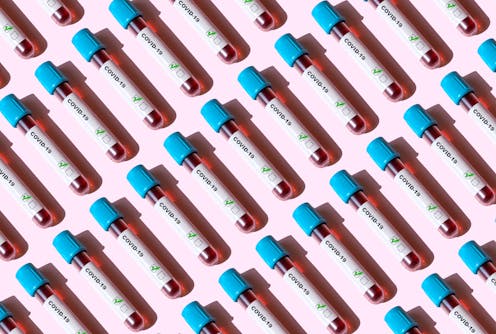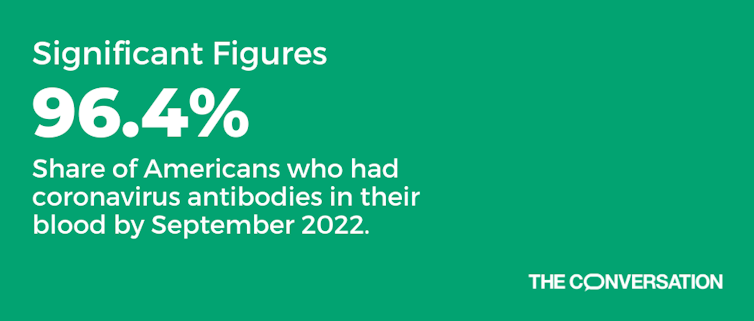96.4% of Americans had COVID-19 antibodies in their blood by fall 2022
There’s pretty much no one left in the US who hasn’t been exposed to the coronavirus, whether by vaccination, infection or both.


Antibodies to SARS-CoV-2, the virus that causes COVID-19, were present in the blood of 96.4% of Americans over the age of 16 by September 2022. That’s according to a serosurvey – an analysis testing for the presence of these immune defense molecules – conducted on samples from blood donors.
A serosurvey like this one helps researchers estimate how many people have been exposed to any part of the coronavirus, whether via vaccination or infection. Both can trigger the generation of antibodies to SARS-CoV-2. And by identifying which kind of antibodies someone has in their blood, researchers can break down the 96.4% into different types of immunity: infection-derived, vaccine-derived and hybrid.
COVID-19 vaccines used in the United States are based on only one part of the virus – the spike, or S, protein. Researchers can tell that a person has been vaccinated and has not been infected if their blood has only anti-S antibodies that target that spike protein. If someone has anti-N antibodies, which target the virus’s nucleocapsid protein, it’s a sign that they’ve been infected by SARS-CoV-2. To reliably identify someone with hybrid immunity, a researcher would need to match someone who has anti-N antibodies to an official vaccination database.
What about the 3.6% without antibodies?
Immunologists know that antibody levels decrease in the months after a COVID-19 infection or vaccination, and this is true for many pathogens. It’s possible some people did have antibodies at one point, but they’re no longer detectable. And not every infection leads to a detectable antibody response, particularly if the case was mild or asymptomatic.
Another factor is the accuracy of the antibody test. No test is perfect, so a small percentage of people who truly have antibodies might come up negative.
Together, these considerations mean that the 96.4% number is likely an underestimate. It seems reasonable to conclude that almost no one in this population has neither been infected by SARS-CoV-2 nor received a COVID-19 vaccine.
A clearer picture of a virus’s spread
Serosurveys are useful for understanding how likely different types of people – of varying ages or races, for example – were to have been infected. For this purpose, a serosurvey can be much more reliable than using data on people who received a positive PCR test, or who report having had a positive rapid antigen test, because getting a positive test is heavily influenced by access to care, health care behavior and how severe your illness is. These are sources of what is called bias.
This bias has two effects: It leads to large underestimation of the proportion of the overall population infected, and it can lead to spurious differences between groups. For example, people with mild symptoms are less likely to get tested and are also likely to be younger. Researchers might draw the wrong conclusion that because they’re not getting tested these people aren’t actually catching the virus.
Looking at antibodies as a marker of infection is not biased by such behavioral factors. Many serosurveys, including ones that we worked on in Chennai, India, and Salvador, Brazil, found similar or even higher seroprevalence in children compared with young adults, contradicting an early narrative that children were less susceptible to the virus. Instead, our results suggested that infections in children were less likely to be detected.
What does this statistic mean for future waves?
Antibodies are not just a marker of previous infection; part of their job is to help prevent future infection with the same pathogen. So, serosurveys can be used to understand levels of immunity in the population.
For some diseases, like measles, immunity is essentially lifelong, and having antibodies means you are protected. However, for SARS-CoV-2 this is not the case, because the virus has continually evolved new variants that are able to reinfect people despite their antibodies.
Nevertheless, many studies have shown that individuals with hybrid immunity will be more protected against future infection and variants than those with vaccine- or infection-derived immunity alone. It may be useful to know the proportion of the population with single-source immunity in order to target certain groups with vaccination campaigns.
Matt Hitchings receives funding from Merck, Sharp and Dohme, US-CDC, National Science Foundation, US National Institutes of Health.
Derek Cummings receives funding from US NIH, US CDC, US NSF, and Merck, Sharp and Dohme.
Read These Next
The celibate, dancing Shakers were once seen as a threat to society – 250 years later, they’re part
‘The Testament of Ann Lee,’ Mona Fastvold’s 2025 film, depicts part of the long history of Shaker…
From truce in the trenches to cocktails at the consulate: How Christmas diplomacy seeks to exploit s
World leaders like to talk up peace at Christmastime. But alongside the tales of seasonal breaks in…
As DOJ begins to release Epstein files, his many victims deserve more attention than the powerful me
Powerful men connected to Jeffrey Epstein are named, dissected and speculated about. The survivors,…






